Art therapy can be defined as an integrative mental health and human services profession that enriches the lives of clients through active art-making, creative processes, applied psychological theory, and human experience within a psychotherapeutic relationship. While art therapy may be viewed as a non-traditional therapy, it does not necessarily need to be an alternative if other therapies are less effective. It can be a great option to look into before more traditional “talk therapies.”

Art therapy can be used to “improve cognitive and sensorimotor functions, foster self-esteem and self-awareness, cultivate emotional resilience, promote insight, enhance social skills, reduce and resolve conflicts and distress, and advance societal and ecological change.” All of these goals are examples of goals in more traditional therapies, but the delivery mechanism is different. It is important and necessary to have other modalities as not every person benefits from traditional psychotherapies.
Creation, exploration, and creativity are all signs of a mentally healthy mind. However, a lot of us may not use these skills or values often, if at all. If we were to utilize these ideas and skills more often, how may that improve our mental and physical health? In more traditional therapies, utilization and identification of thoughts and feelings is in nature explorative, however often in the form of words and sentences.
Benefits of Art Therapy
While there is a lot of merit to exploring your thoughts and feelings verbally, utilizing different avenues (some that you may be unfamiliar with) to draw insight and awareness can be healing. Whether through paint, pencil, drawing, coloring, scribbling, collaging – any form of creation that feels good to you – art therapy allows you to explore thoughts, emotions, and sensations through actively making art and creating a therapeutic relationship.
When we hear the term therapy, we may associate it with having a disorder or diagnosis to “fix.” However, having a mental health diagnosis isn’t necessary to benefit from therapy, and that is no different from art therapy. If you do have a mental health diagnosis that you want to treat, this will be discussed with the art therapist and that will help tailor your goals for sessions (as with any other form of therapy). Many different mental health diagnoses can be treated with art therapy. Therefore, it may be better to decide based on your goals, needs, and the type of therapy you are looking for if you would want to try art therapy. Different conditions and disorders that art therapy can help treat include:
- Depression
- Anxiety
- Substance use disorders
- Eating disorders
- PTSD
- Grief
- Other psychosocial stressors
- Relationship/family conflict
Since art therapy is an exploration of thoughts and feelings utilizing other methods than just speech, this may be a recommended modality if you are someone who struggles to identify or verbalize thoughts and feelings. For example, perfectionism can be a trait that can cause or contribute to stress, anxiety, eating disorders, and mood disturbances. A perfectionist may also find it difficult to talk about how or when they struggle or in showing vulnerability. Through art therapy, you can practice creating and accepting work that you do not like or that you are not “good” at to challenge perfection.
Art therapy is also well known for helping to manage physical ailments and conditions. While art therapy cannot change a physiological condition, it can help bring acceptance and coping with illness. Art therapy is highly effective as a treatment practice with cancer patients. Studies have shown that art therapy can be a strong method in assisting individuals to cope with their medical diagnosis and prognosis, as well as manage any psychological conditions that may come up as a result of their illness. Findings also suggest that art therapy can be effective for those experiencing daily challenges in their lives. Therefore, art therapy can be helpful to many, regardless of life circumstances.
How Art Therapy Works
Art therapists work with all populations. This includes individuals, families, groups, and couples. As with any therapist, some art therapists may have more experience and expertise working with one population over another. There isn’t any certain population that art therapy is geared towards; people of all ages can benefit from art therapy. As you might expect, it can be incredibly effective for children, but adults can also experience positive outcomes. Art therapists practice in a wide variety of settings, including:
- Hospitals
- Schools
- Veteran’s clinics
- Private practices
- Psychiatric and rehabilitation facilities
- Community clinics
- Crisis centers
- Forensic institutions
- Senior communities
The therapists are trained to help clients create art and then discuss it. There are endless examples of activities that art therapists use in their work with clients. Many art therapists use a technique called “active imagination”, where they encourage clients to use free association to think of any thoughts, words, or ideas that come to mind to help create a deeper understanding of their work. Another framework art therapists may use is Gestalt. These methods involve looking at their work as a whole, in the present versus in the past, and from the perspective of the image they created. There is also what is called the “third hand” approach, which is where the therapist becomes involved in helping to create art with the client without distorting their work. This can be a helpful rapport-building exercise, as well.
In more traditional talk therapies, art can also be used to build rapport between the client and the therapist, to express emotions, or to create insight. However, there is a difference between utilizing art projects in therapy and being a registered art therapist (or ATR). Be sure to check the licensure of the therapist to ensure you are getting someone who has been trained and certified in art therapy. A popular example of this is the trendy adult coloring books. While these may be great for distraction, creating calm, and de-stressing, this is not art therapy. An ATR is trained to determine which art exercises and practices will be most effective for someone, and how to modify them as needed. One particular activity may be more helpful for someone who experiences depression but less effective for someone who is coping with relational conflict or trauma.
In Summary
Art therapy is a great therapeutic modality that will help you explore the images and beliefs within you to create something that can develop insight and awareness. Consider this approach if you are feeling stuck or wanting something different out of your therapy experience.
Sources
- Regev, D., & Cohen-Yatziv, L. (2018). Effectiveness of Art Therapy With Adult Clients in 2018-What Progress Has Been Made?. Frontiers in psychology, 9, 1531. https://doi.org/10.3389/fpsyg.2018.01531
- About Art therapy – American Art Therapy Association. (2023, January 18). American Art Therapy Association. https://arttherapy.org/about-art-therapy/
- Art Therapy Credentials Board, Inc. (n.d.). About the credentials | Art Therapy Credentials Board, Inc. https://atcb.org/about-the-credentials/
- Schaverien J. (2005). Art, dreams and active imagination: a post-Jungian approach to transference and the image. The Journal of analytical psychology, 50(2), 127–153. https://doi.org/10.1111/j.0021-8774.2005.00519.x
- Bar-Sela, G., Atid, L., Danos, S., Gabay, N., & Epelbaum, R. (2007). Art therapy improved depression and influenced fatigue levels in cancer patients on chemotherapy. Psycho-oncology, 16(11), 980–984. https://doi.org/10.1002/pon.1175

